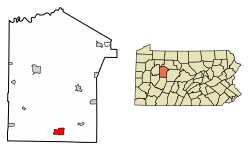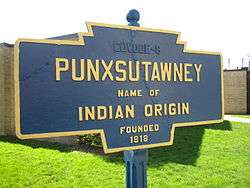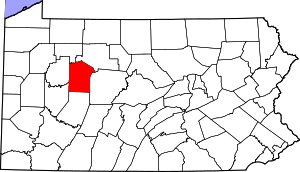Punxsutawney, Pennsylvania
Punxsutawney (/ˌpʌŋksəˈtɔːni/; Lenape: Punkwsutènay[3]) is a borough in the south of Jefferson County, Pennsylvania, United States. Punxsutawney is known for its Groundhog Day celebration each February 2, during which thousands of attendees and international media outlets visit the town for an annual weather prediction by the groundhog Punxsutawney Phil.[4][5]
Punxsutawney, Pennsylvania | |
|---|---|
Borough | |
.jpg) Downtown | |
| Nickname(s): "Weather Capital of the World," "Punxsy" | |
 Location of Punxsutawney in Jefferson County, Pennsylvania. | |
 Punxsutawney Location of Punxsutawney in Jefferson County, Pennsylvania.  Punxsutawney Punxsutawney (the United States) | |
| Coordinates: 40°56′44″N 78°58′31″W | |
| Country | United States |
| State | Pennsylvania |
| County | Jefferson |
| Settled | 1816 |
| Incorporated | 1850 |
| Government | |
| • Type | Borough Council |
| • Mayor | Richard Alexander (R) |
| Area | |
| • Total | 3.42 sq mi (8.85 km2) |
| • Land | 3.35 sq mi (8.68 km2) |
| • Water | 0.06 sq mi (0.17 km2) |
| Elevation | 1,230 ft (370 m) |
| Population (2010) | |
| • Total | 5,962 |
| • Estimate (2019)[2] | 5,704 |
| • Density | 1,701.16/sq mi (656.87/km2) |
| Time zone | UTC-5 (Eastern (EST)) |
| • Summer (DST) | UTC-4 (EDT) |
| Zip code | 15767 |
| Area code(s) | 814 Exchanges: 249, 938, 939 |
| FIPS code | 42-62920 |
| Website | Punxsutawney Chamber of Commerce |
The borough, located 84 miles (135 km) northeast of Pittsburgh and 50 miles (80 km) northwest of Altoona, was incorporated in 1850.[6] With a population of 5,962 as of the 2010 census,[7] Punxsutawney is the largest incorporated municipality in Jefferson County.
History
Shawnee wigwam villages once occupied this site on the Mahoning Creek. The first settlement that included non-indigenous people was in 1772, when Reverend John Ettwein, a Moravian Church missionary, arrived with a band of 241 Christianized Delaware Indians.[8][9] Swarms of gnats plagued early settlers and their livestock for years, and are blamed for Ettwein's failure to establish a permanent settlement there.[8] The clouds of biting gnats eventually drove the Indians away. The Indians called the insects ponkies (living dust and ashes), and called their village Ponkis Utenink (land of the ponkies), from which the present name Punxsutawney evolved. One legend about the origin of the term ponkies concerned an old Indian sorcerer-hermit who was said to have long terrorized Indians in the region. Eventually he was killed, his body burned, and his ashes were cast to the wind. According to the story, the ashes were transformed into minute living things that infested the swamp land.[10][11] Another story about the source of the term asserted that the Indians compared the insect bites to burns caused by sparks or hot ashes.[8]
The area was originally settled by the Lenape (Delaware Native Americans), and a more definitive source says the name "Punxsutawney" derives from a Native name in Unami (a Lenape language): Punkwsutènay, which translates to "town of the sandflies" or "town of the mosquitoes" (punkwës- ‘mosquito’ + -utènay ‘town’).[3] Alternatively, the name is said to come from another Unami term, Put'schisk'tey, which means "poison vine."[12] The Shawnee and Delaware left Pennsylvania and had settled in Ohio by the end of the American Revolution.[9]
The Pennsylvania Department of Transportation (PennDOT) Keystone Marker lists that Punxsutawney was founded in 1818. By 1840 it was reported that Punxsutawney was a village of about 15 or 20 dwellings.[11] Settlers drawn by lumbering and coal mining eventually drained the swamps and exterminated the insects.[8] The Borough of Punxsutawney was incorporated in 1850,[6] and had a reported population of 256 at that time. In 1907, Punxsutawney and Claysville boroughs were consolidated and incorporated as Greater Punxsutawney, resulting in a combined population of 9,058 by 1910. A high-grade bituminous soft coal was mined in the surrounding region. Shortly after 1850, mining was being supplanted by factories which included brickworks, glassworks, tanneries, foundries, ironworks, machine shops, and wood planing, flour, feed, and silk mills. By the 1930s these were mostly gone, and townspeople were dependent largely on the Baltimore & Ohio Railroad repair shops north of town, and a meat packing plant, in addition to the remaining coal mining and batteries of beehive coke ovens.[8] In 1900, 6,746 people lived in Punxsutawney before the consolidation with Claysville. After consolidation, the population in 1910 was 9,058; in 1920, 10,311; in 1930, 9,266; prewar in 1940, 9,482; and postwar in 1950, 8,969 people lived there. The population was 5,962 at the 2010 census.
A groundhog known as Punxsutawney Phil is kept in the town, and is said to predict the weather annually on Groundhog Day (February 2). The event provided the premise for the 1993 film Groundhog Day, although nearly all of the film was shot in Woodstock, Illinois.
The T. M. Kurtz House, Jefferson Theater, Christian Miller House, and United States Post Office-Punxsutawney are listed on the National Register of Historic Places.[13]
Geography
Punxsutawney is located at 40°56′44″N 78°58′31″W (40.945454, -78.975175),[14] roughly 80 miles northeast of Pittsburgh and 150 miles southeast of Erie.
According to the United States Census Bureau, the borough has a total area of 3.4 square miles (8.8 km2). One small river, Mahoning Creek, winds through the town. It is bordered on the north, west, and south by Young Township, and on the east by Bell Township.
Demographics
| Historical population | |||
|---|---|---|---|
| Census | Pop. | %± | |
| 1850 | 256 | — | |
| 1860 | 415 | 62.1% | |
| 1870 | 553 | 33.3% | |
| 1880 | 674 | 21.9% | |
| 1890 | 2,792 | 314.2% | |
| 1900 | 4,375 | 56.7% | |
| 1910 | 9,058 | 107.0% | |
| 1920 | 10,311 | 13.8% | |
| 1930 | 9,266 | −10.1% | |
| 1940 | 9,482 | 2.3% | |
| 1950 | 8,969 | −5.4% | |
| 1960 | 8,805 | −1.8% | |
| 1970 | 7,792 | −11.5% | |
| 1980 | 7,479 | −4.0% | |
| 1990 | 6,782 | −9.3% | |
| 2000 | 6,271 | −7.5% | |
| 2010 | 5,962 | −4.9% | |
| Est. 2019 | 5,704 | [2] | −4.3% |
| Sources:[15][7][16] | |||
As of the census[7] of 2010, there were 5,962 people, 2,573 households and 1,602 families in the borough. The population density was 1,836.2 people per square mile (708.0/km²). There were 3,042 housing units at an average density of 890.7 per square mile (343.4/km²). The racial makeup of the borough was 98.8% White, 0.2% African American, 0.2% Native American, 0.3% Asian, <0.1% from other races, and 0.5% from two or more races. Hispanic or Latino of any race were 0.8% of the population.
There were 2,749 households, out of which 25.3% had children under the age of 18 living with them, 41.0% were married couples living together, 13.5% had a female householder with no husband present, and 41.7% were non-families. 37.8% of all households were made up of individuals, and 20.6% had someone living alone who was 65 years of age or older. The average household size was 2.19 and the average family size was 2.89.
In the borough the population was spread out, with 21.3% under the age of 18, 9.9% from 18 to 24, 25.1% from 25 to 44, 21.6% from 45 to 64, and 22.2% who were 65 years of age or older. The median age was 41 years. For every 100 females there were 80.9 males. For every 100 females age 18 and over, there were 77.2 males.
The median income for a household in the borough was $26,250, and the median income for a family was $33,054. Men had a median income of $28,958 versus $19,076 for women. The per capita income for the borough was $14,802. About 13.3% of families and 16.9% of the population were below the poverty line, including 20.6% of those under age 18 and 12.8% of those age 65 or over.
Government
The Borough of Punxsutawney is governed by seven Council members, each elected to a four-year term. The members are: Brian Smith, President; Lawrence Chenoga, Vice-President; Jeanne Porada, President Pro-Tem; James Bianco; Jaime Sherry; Cynthia Rebuck; and Robert "Toby" Santik.
The Mayor, Richard Alexander, is also elected to a four-year term, and in addition to other duties, has oversight of the Borough Police Department.
Other elected offices include: one Tax Collector (four-year term) and six constables (four-year terms).
The Borough Manager position, held by Benjamin White, is the Chief Administrative Officer of the Borough, and reports to Borough Council.
Punxsutawney is the most populous incorporated municipality in Jefferson County.
Education
The Punxsutawney Area School District serves the borough of Punxsutawney and the surrounding area for K-12 education. The district has two secondary buildings (Punxsutawney Area High School & Punxsutawney Area Middle School) and six elementary buildings (Jenks Hill, Bell Township, Longview, Mapleview, Parkview, West End).[17] However, as of the 2018-2019 school year, the six elementary schools have been consolidated, and students in grades K-6 will attend Punxsutawney Area Middle School while students in grades 7-12 will attend Punxsutawney Area High School.[18]
Punxsutawney Christian School and SS. Cosmas & Damian School (SSCD) are two private schools in Punxsutawney.[19][20]
Emergency services
The Borough of Punxsutawney employs a full-time police service made up of 12 police officers. The Chief of Police is Matt Conrad.[21] Dispatchers and wardens are also employed by the borough and work closely with police. The police station is staffed 24 hours a day, 7 days a week, by both police officers and wardens.
The Punxsutawney Fire Department is made up of three volunteer stations, The Central Fire Dept. (Jefferson County Station 20), Elk Run Volunteer Fire Company (Jefferson County Station 30), and Lindsey Fire Company (Jefferson County Station 40). The president of the Punxsutawney Fire Department is Tami McFarland. The Fire Department Chief is Brian Smith. In addition to department officers, each station elects its own officers. Scott Depp is the chief of Central Fire Dept., Doug McAfoos the chief of Elk Run VFC, and Joe DeFelice, Jr. the chief of Lindsey Fire Co. The fire department responds to fires, vehicle accidents, hazardous materials incidents, and rescue situations in the borough of Punxsutawney, Bell Township, and Young Township. The Punxsutawney Fire Department also maintains an active water rescue team comprising scuba divers and a boat crew.
Jefferson County EMS operates the ambulance station in Punxsutawney. Station 50 is a full advanced life support service comprising paramedics and emergency medical technicians. Station 50 serves not only the borough of Punxsutawney, but also Southern Jefferson County and parts of Northern Indiana County.
Media
Notable people
- Britt Baker (born 1991), a professional wrestler currently performing for All Elite Wrestling.
- Chuck Daly (July 20, 1930 – May 9, 2009) was a basketball head coach. He had a 14-year NBA coaching career and began his basketball coaching career in 1955 at Punxsutawney Area High School.
- Wilbur Good was a Major League Baseball player for the Philadelphia Phillies and other teams in the early 20th century.
- Bill Hunter, a baseball shortstop, coach, and manager.
- Lloyd Jordan (1900–1990) was head coach at Harvard and was inducted in the College Football Hall of Fame.
- Devin Mesoraco (born 1988) was a Major League Baseball catcher for the New York Mets and Cincinnati Reds. He was the 15th overall pick in the 2007 draft.
- John Mizerock (born December 8, 1960, in Punxsutawney) was a backup catcher for the Houston Astros and the Atlanta Braves. He was the eighth overall pick in the 1979 draft. He is currently the hitting coach of the Philadelphia Phillies Minor League Class A Advanced affiliate, the Clearwater Threshers, of Clearwater, FL.
- Cast of the popular series Breaking Amish
See also
| Wikimedia Commons has media related to Punxsutawney, Pennsylvania. |
- Groundhog Day - 1993 film set in Punxsutawney.
- Groundhog Day Musical - 2017 musical based on the Film.
References
- "2019 U.S. Gazetteer Files". United States Census Bureau. Retrieved July 28, 2020.
- "Population and Housing Unit Estimates". United States Census Bureau. May 24, 2020. Retrieved May 27, 2020.
- "Punxsutawney (lit: mosquito town)". Lenape Talking Dictionary. Archived from the original on 2011-07-28. Retrieved 2012-05-27.
From punkwës- = mosquito plus -utènay = town
- "Groundhog Day: Punxsutawney Phil Predicts 6 More Weeks Of Winter". NPR.org. Retrieved 2020-02-03.
- "Groundhog Day: Punxsutawney Phil doesn't see shadow, predicts early sprin". The Jerusalem Post | JPost.com. Retrieved 2020-02-03.
- "The Borough of Punxsutawney". Retrieved Oct 24, 2019.
- "U.S. Census website". United States Census Bureau. Retrieved 2008-01-31.
- Pennsylvania: A Guide to the Keystone State (Illustrated). Oxford University Press, 1940. University of Pennsylvania, Federal Works Agency. p. 568. Google Books.
- The WPA Guide to Pennsylvania: The Keystone State. Trinity University Press, 2013. p. 568. Google Books, & Amazon Kindle.
- McKnight, William J., M.D. A Pioneer History of Jefferson County, Pennsylvania. J.B. Lippincott Company, 1898. Chapter: Sunday, July 19th. p. 235. Google Books.
- McKnight, William James. A Pioneer Outline History of Northwestern Pennsylvania (Illustrated). J.B. Lippincott Company, 1905. Donation Lands. Google Books.
- Brinton, Daniel G., C.F. Denke, and Albert Anthony. A Lenâpé - English Dictionary. Biblio Bazaar, 2009. ISBN 978-1103149223, p. 121.
- "National Register Information System". National Register of Historic Places. National Park Service. July 9, 2010.
- "US Gazetteer files: 2010, 2000, and 1990". United States Census Bureau. 2011-02-12. Retrieved 2011-04-23.
- "Census of Population and Housing". U.S. Census Bureau. Retrieved 11 December 2013.
- "Incorporated Places and Minor Civil Divisions Datasets: Subcounty Resident Population Estimates: April 1, 2010 to July 1, 2012". Population Estimates. U.S. Census Bureau. Archived from the original on 11 June 2013. Retrieved 11 December 2013.
- "Building Address & Contact Info". Punxsutawney Area School District. Retrieved 26 August 2015.
- McClure, Bridget. "Punxsutawney School Board decides on consolidation plan". WJAC. Retrieved 2018-08-17.
- "Punxsutawney Christian School". Punxsutawney Christian School. Retrieved 26 August 2015.
- "Ss. Cosmas & Damian Roman Catholic School". Archived from the original on 28 September 2015. Retrieved 26 August 2015.
- "Conrad in as new police chief". Retrieved 12 October 2016.

